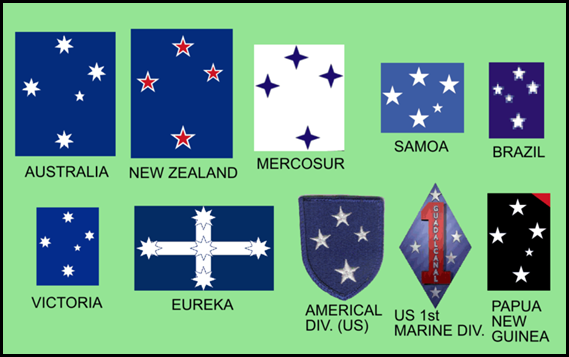Southern Cross

|
Cruz or The Southern
Cross
We first saw the
Southern Cross on our journey from Roatan to Providencia. It showed
itself above the horizon on our port bow, laying to the left, as the night went
on it seemed to rise higher, come upright and around four in the morning it
disappeared on our right. It is more usual to see just the four main stars and
not epsilon Cru, maybe that’s the reason the New Zealand flag only has the four
(the Australian flag has the five). I woke Bear on our journey here one night to
see all five stars, a first for both of us. Here in the Gambiers we only get to
see the Cruz on clear nights but always a joy to see.
Crux is the smallest of the eighty eight modern constellations, but is one of the most distinctive. Its name is Latin for cross, and it is dominated by a cross-shaped asterism that is commonly known as the Southern Cross.
Visibility: The five brightest stars in Crux are clearly visible in the top right. The red giant Gacrux and orange giant Epsilon are distinctly different from the three other major stars of the constellation, which are blue-white in colour. Crux is easily visible from the southern hemisphere at practically any time of year. It is also visible near the horizon from tropical latitudes of the northern hemisphere for a few hours every night during the northern winter and spring. For instance, it is visible from Cancun or any other place at latitude 25° N or less at around 10 pm at the end of April.
Location and identification: Crux is bordered by the constellations Centaurus (which surrounds it on three sides) and Musca. Crux is sometimes confused with the nearby False Cross by stargazers. Crux is somewhat kite-shaped, and it has a fifth star (ε Crucis). The False Cross is diamond-shaped, somewhat dimmer on average, does not have a fifth star and lacks the two prominent nearby "Pointer Stars."
Markers: Since the southern sky lacks an easily visible pole star, Alpha and Gamma (known as Acrux and Gacrux respectively) are commonly used to mark south. Tracing a line from Gacrux to Acrux leads to a point close to the Southern Celestial Pole.
The Stars Acrux, is a triple star 321 light-years from Earth. Beta Crucis, called Mimosa, is a blue-hued giant 353 light-years from Earth. Gacrux, is a double star. The primary is a red-hued giant star, 88 light-years from Earth. The secondary is 264 light-years away. Delta Crucis is a blue-white hued star 364 light-years from Earth. It is the dimmest of the Southern Cross stars.
History: The Ancient Greeks; Ptolemy regarded it as part of the constellation Centaurus. It was entirely visible as far north as Britain in the fourth millennium BC. However, the precession of the equinoxes gradually lowered its stars below the European horizon, and they were eventually forgotten by the inhabitants of northern latitudes. By AD 400, most of the constellation never rose above the horizon for Athenians. The 15th century Venetian navigator Alvise Cadamosto made note of what was probably the Southern Cross on exiting the Gambia River in 1455, calling it the carro dell'ostro ("southern chariot"). However, Cadamosto's constellation had too many stars and was tilted incorrectly. Historians generally credit Mestre João Faras - astronomer and physician of King Manuel I of Portugal who accompanied Pedro Álvares Cabral in the discovery of Brazil in 1500 - for being the first European to depict it correctly. Faras sketched and described the constellation (calling it "Las Guardas") in a letter written on the beaches on the 1st of May, to the Portuguese monarch, King Manual I. Émerie Mollineux has also been cited as the first uranographer to distinguish Crux; his illustration dates to 1592. Later adopters of the constellation included Jakob Bartsch in 1624 and Augustin Royer in 1679. Royer is also sometimes cited as initially distinguishing Crux. Explorer Amerigo Vespucci depicted Crux as an almond, called "Mandorla". The separation of Crux from Centaurus is generally attributed to the French astronomer Augustin Royer in 1679, but other historians attribute the invention of Crux to Petrus Plancius in 1613. However, Crux was later published by Jakob Bartsch in 1624.
Flags and symbols: Beginning in the colonial age, Crux became used as a national symbol by several southern nations. The brightest stars of Crux appear on the flags of Australia, Brazil, New Zealand, Papua New Guinea and Samoa. They also appear on the flags of the Australian state of Victoria, the Australian Capital Territory, the Northern Territory, as well as the flag of Magallanes Region of Chile, the flag of Londrina (Brazil) and several Argentine provincial flags and emblems (for example, Tierra del Fuego and Santa Cruz). The flag of the Mercosur trading zone displays the four brightest stars. Crux also appears on the Brazilian coat of arms.
In non-Western astronomy: The stars are mentioned in so many ways by so many different peoples, these few are our favourites. In Australian Aboriginal astronomy, Crux and the Coalsack mark the head of the 'Emu in the Sky' in several Aboriginal cultures, while Crux itself is said to be a possum sitting in a tree and a representation of the sky deity Mirrabooka. In ancient Hindu astrology, the modern Crux is referred to as Trishanku. In Indonesia and Malaysia, it is known as Buruj Pari (the constellation of the Stingray).
Namesake: USS Crux (AK-115) was a United States Navy Crater class cargo ship named after the constellation.
ALL IN ALL A SPECIAL BEACON
A BRILLIANT
FIRST |
